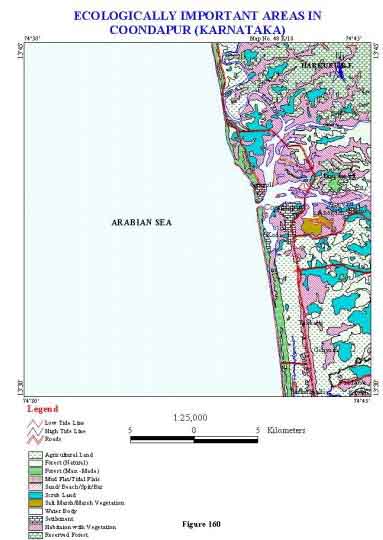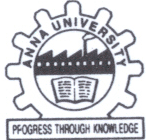|

Home
Introduction
Objectives
Methodology
Ecologically
Important Areas
Information
in Detail
|
Coondapur:
Coondapur town is located at 13°30'-
13°45'N latitude and 74°03'-74°45' E longitude respectively. The Haladi is the
main river in this area. It descends from the Western Ghats to the Arabian Sea.
It slows down as it reaches the coast and spreads out into wide estuaries, lagoons,
and backwaters with extensive mudflat and small patches of mangrove forest. The
mouth of the estuaries and creek are narrow and prominently open to the sea. Many
fish and prawn farms are located in the vicinity of the mangrove areas. Mangrove
forest is particularly well developed in this river near Gangolli. Much of the
intervening coastline is sandy beach backed by coastal dunes, but there are some
short stretches of rocky shore. The important wetland classes in Coondapur are
illustrated in the Table 3.
Table 3: Wetland classes and its area
extent of Coondapur
S
No | Wetland
classes | Area
in kmē | 01 | Mud
Flat | 1.90 | 02 | Sandy
Area | 2.76 | 03 | Salt
Marsh | 2.64 |
Fig:
Ecologically Important Area in Karnataka, Coondapur

Flora:
Estuarine
mangrove forest consists of 14 species of mangrove belonging to seven families.
Avicennia
officinalis, A. marina, Kandelia candel, Rhizopora mucronata, Sonneratia alba,
Aegiceras corniculatum, Excoecaria agallocha alba, K. candel, Sonneratia caseolaris,
Acanthus ilicifolius, clerodendrum inerme
and Rhizophora
conjugate
are the important
mangrove species in this area.
The backwaters support
a variety of algae, including
Enteromorpha
intestinalis, Chaetomorpha lineum, Monostroma sp., Porphyra uietnamensis,
and
Gracilaria
uerrucosa. The
coastal sand dune vegetation is dominated by
Impomoea
pescaprae, Asparagus dumosus, Spinifex littoreus, Cyperus aristatus, Sporobolus
tremulus, Leucas aspera,
and
Casuarina
equisetifolia
on the foreshore,
and
Vitex
negundo, Pandanus sp., Durana repens, Anacardium occidentale,
and Cocos
nucifera
on the backshore.
Fauna:
The
estuaries sustain rich populations of fishes, crustaceans, and molluscs, species
of commercial importance include fishes of the genera Chanos,
Mugil, Arius, Gerrus, Ploynemus, Periophthalmus, Caranx, Epinephalus,
and Therapon;
shrimps of genera Penaeus,
Macrobrachium, Metapenaeus, and Alphaeus;
crabs of the genera Uca,
Neptunus,
and Thalassira;
and a variety of clams and oysters.
|



